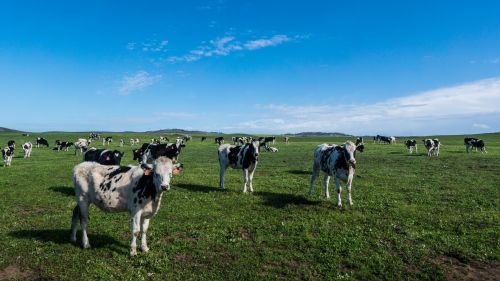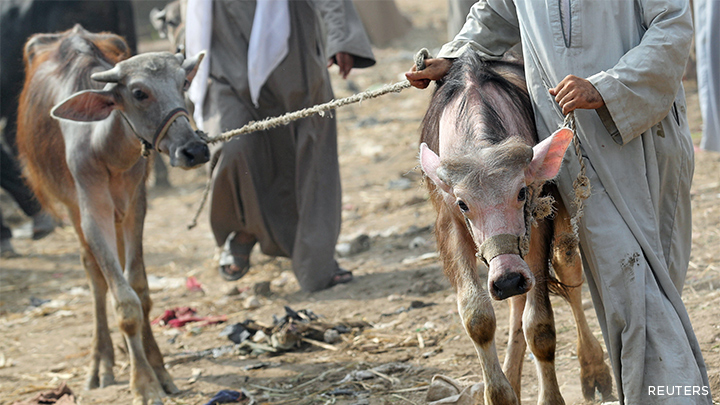The Livestock Ladder’s Water Footprint

In this post from our "Uncharted Waters" blog series, we discuss that while the water footprint of livestock is substantive, the cost of that footprint is far from straightforward.
Livestock's water footprint
The food we eat is more than the meal on our plate. It’s the resources that went into producing that food: the land, water, and fertilizer used to grow crops; the energy and petroleum resources needed to run tractors, machinery, and supply chains. In the case of meat, poultry, and dairy, it’s not just all the inputs needed to keep raise healthy animals but also the inputs needed to grow and transport those animals’ feed.
Animal-sourced foods, simply put, have an outsized footprint. Livestock are the apex of a far more complex and involved production system than that which produces grains or produce. It takes magnitudes more water, more land, more time and energy. And its impact on the environment, consequently, is magnitudes larger.
This isn’t news, of course. We know that it takes a great deal more effort to produce a pound of beef than it does a pound of potatoes and the significant price difference between those two foods at the grocery store reflects this. It’s also no secret that there is an increasing dialogue, especially in high-income countries, around limiting consumption of animal-sourced foods to lessen our diets’ impact on the planet.;
But this conversation misses one enormous benefit of livestock: they are among the most effective tools we have to lift smallholder farmers out of poverty. Called the “livestock ladder,” the process by which smallholders climb up the scale of production and out of poverty, livestock provide smallholders with food, nutrition, income, employment and act as a reserve of assets and savings. Livestock are often the entry point for smallholder farmers to join—and benefit from—complex value chains that extend well beyond the farm gate. Dairy in particular is often cited as an entry point for smallholder farmers to begin the production of value-added products. Manure is a valuable source of fertilizer; leather and wool are valuable sources of fiber. Importantly, livestock provide critical nutrition for well over a billion of the world’s poorest, most nutrition-insecure people.
But what’s the water cost of all this?
Globally, around 70 percent of all water used by humans is used for agriculture. And within agriculture, livestock use between 24-32 percent of agricultural water—put another way, between approximately a fifth to a quarter of all water used by humans is used to raise livestock. That is undeniably a lot of water, but it is not a straightforward water cost.
Water is used as drinking water for animals as well as cleaning and cooling animals. It is necessary for processing animals at abattoir and for processing animal byproducts like leather. But these liquid, fresh-water inputs—the “blue water” cost of livestock—is small, with only about 0.2 percent of the total water footprint of livestock is attributed to these water uses.
So where does the other 99.8 percent of the water footprint (a fifth to a quarter of all human water use) come from? It comes from livestock feed. Referred to as “green water,” this is the moisture in the soil that plants and crops use to grow and to produce the fodder and grain that livestock eat.
A green water footprint is not quite the same as a blue water footprint. Green water does not flow in rivers. It can’t be stored behind dams. And it doesn’t flow through pipes as drinking water. It is place-dependent, and using it to grow crops isn’t intrinsically a drain on water resources. However, that’s not to say that it’s without cost, or that efficiencies would not yield significant water conservation.
Specifically, improvements in livestock efficiency—the ratio between livestock inputs, like water-intensive feed, and outputs, like meat and dairy—hold the possibility to dramatically improve the water efficiency of agriculture overall. And there are a few key opportunities to do so.
One direction is to improve the health of the animals themselves. Veterinary care, proper nutrition, and improved animal genetics thanks to breeding the most productive animals means animals are able to grow and produce at their full potential and waste fewer resources. An ill or undernourished cow will produce far less milk on the same amount of feed as a healthy cow receiving proper nutrition. Likewise, if an animal dies from disease or lack of veterinary care before it reaches an appropriate age to harvest, the accrued water footprint of all the feed it had been fed up until that point is effectively wasted.

Another key direction is to improve the water efficiency of livestock feed. When possible, livestock feed should be grown where it is easiest to grow. Where green water is plentiful, and water stress is low, farmers can efficiently grow feedstuff crops and then export to areas that are otherwise water-stressed. Another opportunity to improve the water efficiency of livestock feed is to incorporate more of the non-grain portions of crops grown for human consumption such as sorghum and teff into animal feed. Portions of these plants, like the stems and leaves, are inedible to humans but perfectly edible to many animals. Because these crops were otherwise grown for human consumption, using the non-grain portion of the plant as livestock feed comes with no additional water cost.
While the water footprint of livestock is substantive, the cost of that footprint is far from straightforward. Livestock are a critical tool in the elimination of extreme poverty and provide vital nutrition and financial assets to more than a billion of the world’s poorest people. There is no denying that improvements can be made to the water efficiency of livestock writ large, and in many low- and middle-income countries the ceiling for improvements is incredibly high. Though improvements in animal husbandry and animal feed production, livestock can be a part of both a sustainable food system and a tool for successful economic development.
"Unchartered Waters" Series
- Farmer-Led Irrigation for Agricultural Intensification
- Achieving Food and Nutrition Security in the Face of Water Scarcity
- Growing Cities, Changing Diets
- The Livestock Ladder’s Water Footprint
- Are the Sustainable Development Goals for Water and Food Working Against One An…
- From Chicago to Uganda, Clean Water is Key to Good Nutrition
- The Gendered Burden of Water